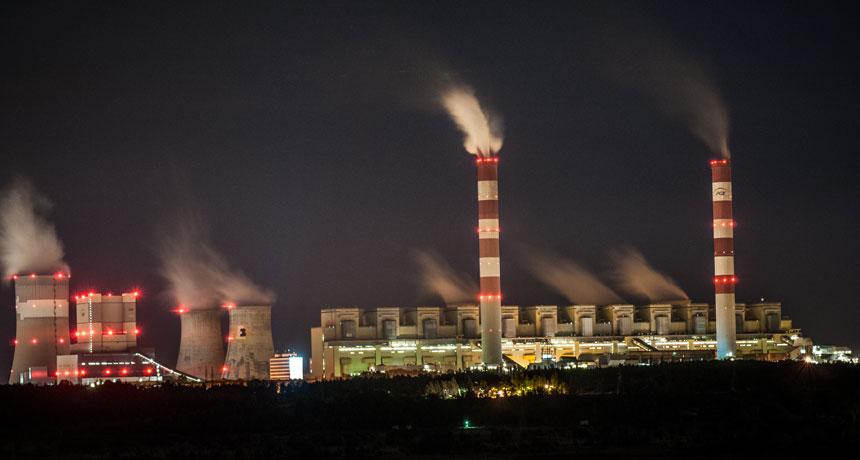The heat that keeps on giving
Carbon dioxide traps far more warmth than its source fossil fuels release when burned

This power plant in Poland burns coal to generate heat. A new study calculates how the carbon dioxide released when burning fossil fuels eventually causes far more warming, by trapping heat in Earth’s atmosphere.
Kamil Porembiński/Flickr/(CC BY-SA 2.0)
By Beth Geiger
Thousands of power plants around the world burn coal, oil or natural gas. The combustion of these fossil fuels generates heat. That heat is used to make electricity. When burned, fossil fuels also release carbon dioxide (CO2). In the atmosphere, this invisible gas traps heat that otherwise would escape into space, warming the planet. This indirect heating does much more to warm Earth — and that heat persists for a longer time — than the initial burning of the fossil fuel, a new study finds.
For their new study, Xiaochun Zhang and Ken Caldeira looked at both kinds of heating. Both experts are climate scientists at the Carnegie Institution for Science in Stanford, Calif. They calculated how the heating effects of that extra CO2 compare with the heat released when fossil fuels are burned in the first place.
Burning fossil fuels provides a brief pulse of warming. But the warming brought on by the CO2 released at the same time lasts for centuries, the new calculations show.
Carbon dioxide is a greenhouse gas. Just like the glass in a greenhouse, CO 2 in the atmosphere traps heat. That extra warmth causes average global temperatures to rise. The CO 2 emissions that come from burning fossil fuels are considered a leading cause of climate change.Zhang and Caldeira began their study by obtaining data on carbon dioxide emissions from a 2013 report published by the Intergovernmental Panel on Climate Change. This international group includes the world’s top climate scientists.
Using computer models, Zhang and Caldeira calculated how much heat is given off when coal, oil or natural gas is burned. (Each fossil fuel produces different amounts of heat and carbon dioxide when burned.) They also determined how much heat is trapped on Earth by the burning of those fossil fuels over the following days and weeks. That let the scientists compare how quickly the warming from greenhouse gas emissions would exceed the heat given off by burning the fuels.
Imagine, for example, burning one lump of coal. This produces immediate heat. Over the next 34 days, though, the carbon dioxide released by that burning lump will have trapped more heat on Earth than was released when the coal burned, Zhang and Caldeira calculated. For oil, it would take 45 days. And for natural gas, 59 days.
Even worse, says Caldeira, carbon dioxide lingers in the atmosphere. That means it keeps on warming our planet for thousands of years. “Eventually,” he told Science News for Students, “that lump of coal prevents more than 100,000 times the energy it released in the first place from escaping into space.” He finds that a “startling number.”
These findings appear in the June 2 issue of Geophysical Research Letters.
Pierre Friedlingstein is a climate scientist. He works at the University of Exeter in England. He says he was “not at all” surprised by the findings. He also notes that the direct heating is a local effect, like a hot car engine. But the longer-term greenhouse effects are global. The new findings confirm that CO2 emissions and the greenhouse effect truly are a “big issue,” he says.
Caldeira acknowledges that his team’s results are not really new news. Roger Sathre, a climate researcher with the Lawrence Berkeley National Laboratory in Berkeley, Calif., came to similar conclusions in a 2013 study. Instead, Caldeira explains, he and Zhang simply wanted to put a down-to-earth spin on the data. “We were trying to get numbers people could get a grip on,” he explains.
Power Words
(for more about Power Words, click here)
atmosphere The envelope of gases surrounding Earth or another planet.
carbon dioxide A colorless, odorless gas produced by all animals when the oxygen they inhale reacts with the carbon-rich foods that they’ve eaten. Carbon dioxide also is released when organic matter (including fossil fuels like oil or gas) is burned. Carbon dioxide acts as a greenhouse gas, trapping heat in Earth’s atmosphere. Plants convert carbon dioxide into oxygen during photosynthesis, the process they use to make their own food. Its symbol is CO2.
climate The weather conditions prevailing in an area in general or over a long period.
climate change Long-term, significant change in the climate of Earth. It can happen naturally or in response to human activities, including the burning of fossil fuels and clearing of forests.
combust To consume by fire. Combustion is the process of burning.
computer model A program that runs on a computer that creates a model, or simulation, of a real-world feature, phenomenon or event.
fossil fuels Any fuel — such as coal, petroleum (crude oil) or natural gas — that has developed in the Earth over millions of years from the decayed remains of bacteria, plants or animals.
geophysics The study of matter and energy on Earth and how they interact.
global warming The gradual increase in the overall temperature of Earth’s atmosphere due to the greenhouse effect. This effect is caused by increased levels of carbon dioxide, chlorofluorocarbons and other gases in the air, many of them released by human activity.
greenhouse gas A gas that contributes to the greenhouse effect by absorbing heat. Carbon dioxide is one example of a greenhouse gas.
greenhouse effect The warming of Earth’s atmosphere due to the buildup of heat-trapping gases, such as carbon dioxide and methane. Scientists refer to these pollutants as greenhouse gases. The greenhouse effect also can occur in smaller environments. For instance, when cars are left in the sun, the incoming sunlight turns to heat, becomes trapped inside and quickly can make the indoor temperature a health risk.
fossil fuels Any fuel — such as coal, petroleum (crude oil) or natural gas — that has developed in the Earth over millions of years from the decayed remains of bacteria, plant or animals.
Intergovernmental Panel on Climate Change, or IPCC. This international group keeps tabs on the newest published research on climate and on how ecosystems are responding to it. The United Nations Environment Program and the World Meteorological Organization jointly created the IPCC in 1988. Their aim was to provide the world with a clear scientific view on the current state of knowledge on climate change and its potential environmental and social impacts.
natural gas A mix of gases that developed underground, like crude oil (and often in association with crude oil) over, millions of years. Most natural gas starts out as 50 to 90 percent methane, along with small amounts of heavier hydrocarbons, such as propane and butane.
power plant An industrial facility for generating electricity.







